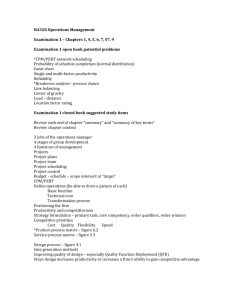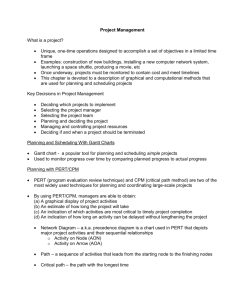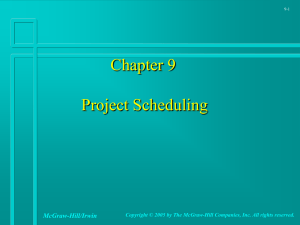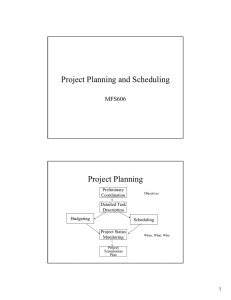Systems Analysis & Design Sixth Edition Toolkit Part 4
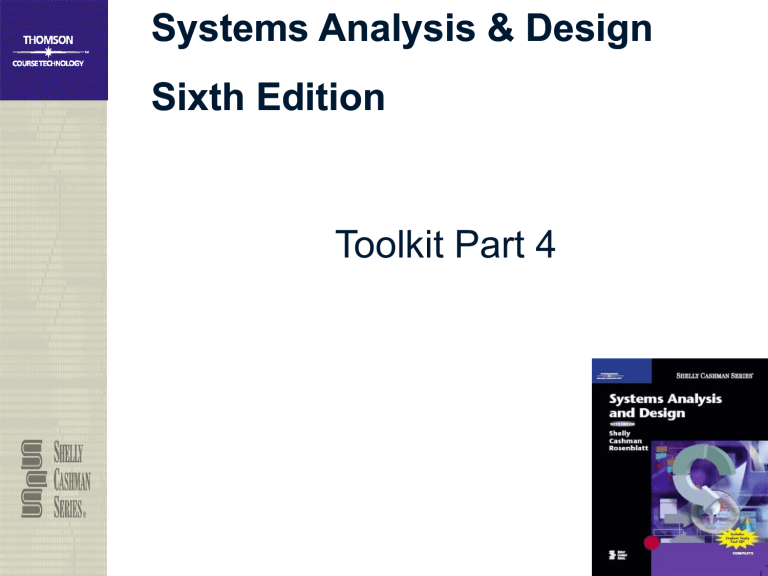
Toolkit Part 4
Toolkit Objectives
● Describe project management tools and how they are used
● Describe the steps used in project planning, scheduling, monitoring and controlling, and reporting
● Explain techniques for estimating task completion times and costs
● Describe various scheduling tools, including Gantt charts and PERT/CPM charts
Toolkit Objectives
● Calculate completion times, start dates, and end dates for a project
● Explain the steps involved in software change control
● Understand the reasons why projects sometimes fail
Introduction
● You will learn about project planning, scheduling, monitoring, reporting, and the use of project management software
● You also will learn how to control and manage project changes that typically occur
Project Management Overview
● Project Management
● The goal of project management is to deliver an information system that is acceptable to users and is developed on time and within budget
● Project manager or project leader
● Project coordinator
Project Management Overview
● Project managers typically perform four main tasks:
– Project planning
– Project scheduling
– Project monitoring and controlling
– Project reporting
Project Planning
● Takes place at the beginning and end of each SDLC phase
● Task or activity
● Event or milestone
Project Planning
● The project manager leads and coordinates the team, monitors events, and reports progress
● Identifying Tasks
– One of the most important variables is the size of the project, because the amount of work does not relate directly to the size of the project
– If one project is twice the size of another project, the larger project will take more than twice as many resources to develop
Project Planning
● Identifying Tasks
– Six times as many relationships can mean more delay, misunderstanding, and difficulty in coordinating tasks
– The capabilities of project team members also affect time requirements
– A less experienced analyst usually will need more time to complete a task than an experienced team member will
Project Planning
● Estimating Task Completion Time and
Cost
– Person-days
– Some tasks can be divided evenly so it is possible to use different combinations of time and people, up to a point
– In most systems analysis tasks, however, time and people are not interchangeable
Project Planning
● Estimating Task Completion Time and
Cost
– Best-case estimate (B)
– Probable-case estimate (P)
– Worst-case estimate (W)
– Weight
– Expected task duration:
(B+4P+W)
6
Project Planning
● Factors Affecting Time and Cost
Estimates
– Project size and scope
– IT resources
– Prior experience with similar projects or systems
– Constraints
Overview of Project Scheduling
● Project scheduling involves the creation of a specific timetable
● Dependent task
● Must balance task time estimates, sequences, and personnel assignments
● Several graphical planning aids can help
Project Scheduling with Gantt Charts
● Gantt Chart
● A detailed Gantt chart for a very large project might be quite complex and hard to understand
● Task groups
● Not an ideal tool for controlling a complex project
Project Scheduling with PERT/CPM
Charts
● The Program Evaluation Review
Technique (PERT)
● Critical Path Method (CPM)
● The important distinctions between the two methods have disappeared over time, and today the technique is called either PERT, or CPM, or PERT/CPM
Project Scheduling with PERT/CPM
Charts
● Overview of PERT/CPM
– PERT/CPM is called a bottom-up technique
– Project tasks
– Once you know the tasks, their duration, and the order in which they must be performed, you can calculate the time that it will take to complete the project
Project Scheduling with PERT/CPM
Charts
● PERT/CPM Chart Format
– Task box
– T (task duration or time)
– ES (earliest start)
– EF (earliest finish) – expected project duration
– LF (latest finish)
– LS (latest start)
Project Scheduling with PERT/CPM
Charts
● Task Patterns
– Sequential tasks
– Multiple successor tasks
• Concurrent task
• Predecessor task
• Successor task
– Multiple Predecessor Tasks
Project Scheduling with PERT/CPM
Charts
● Complex Task Patterns
Project Scheduling with PERT/CPM
Charts
● A PERT/CPM Example with Five Tasks
Project Scheduling with PERT/CPM
Charts
● Critical Path
– Slack time
– If any task along the critical path falls behind schedule, the entire project is delayed
– A critical path includes all tasks that are vital to the project schedule
Project Scheduling with PERT/CPM
Charts
● Transforming a Task List into a
PERT/CPM Chart
– You must develop three versions:
• Version 1: Basic Structure
• Version 2: Enter ES and EF Values
• Version 3: Add LF and LS Values
– After you enter the LS and LS figures, you will be able to identify the critical path
Project Scheduling with PERT/CPM
Charts
● Transforming a Task List into a
PERT/CPM Chart
Project Scheduling with PERT/CPM
Charts
● Comparing Gantt Charts and PERT/CPM
– One significant advantage of PERT/CPM charts is that all individual tasks and dependencies are shown
– A PERT/CPM chart displays the critical path for the overall project and the slack time
– A Gantt chart offers a rapid overview
– PERT/CPM and Gantt charts are not mutually exclusive techniques
Project Monitoring and Controlling
● Monitoring and Control Techniques
– The project manager must keep track of tasks and progress of team members, compare actual progress to the project plan, verify the completion of project milestones, and set standards and ensure that they are followed
– Structured walkthrough
– Called design reviews, code reviews, or testing reviews
Project Monitoring and Controlling
● Maintaining a Schedule
– Maintaining a project schedule can be a challenging task
– The better the original plan, the easier it will be to control the project
– If enough milestones and frequent checkpoints exist, problems will be detected rapidly
– It is mathematically possible for a project to have more than one critical path
Project Reporting
● Project Status Meetings
– Most project managers schedule regular status meetings with the entire project team
Project Reporting
● Project Status Reports
– A project manager must report regularly to his or her immediate supervisor, upper management, and users
– Should explain what you are doing to handle and monitor the problem
– Most managers recognize that problems do occur on most projects; it is better to alert management sooner rather than later
Project Management Software
● Project Management Software
● Project Management Example Using
Microsoft Project
– Create a Gantt chart showing the necessary information
– After you complete the Gantt chart, you decide to view the data in the form of a PERT chart
Project Management Software
● Project Management Example Using
Microsoft Project
– Network diagram
– Each task box contains the task description, task identification number, task duration, start date, and end date
– Project planning is a dynamic task and involves constant change
Software Change Control
● Software Change Control
● A procedure for processing requests for changes to an information system’s requirements consists of four steps:
1.
Complete a change request form
2.
Take initial action on the request
3.
Analyze the impact of the requested change
4.
Determine the disposition of the requested change
Keys to Project Success
● Business Issues
– The major objective of every system is to provide a solution to a business problem or opportunity
– A system that falls short of business needs also produces problems for users and reduces morale and productivity
Keys to Project Success
● Budget Issues
– Cost overruns typically result from one or more of the following:
• Unrealistic estimates
• Failure to develop an accurate TCO forecast
• Poor monitoring of progress and inadequate reaction to early signs of problems
• Schedule delays due to unanticipated factors
• Human resource factors
Keys to Project Success
● Schedule Issues
– Problems with timetables and project milestones can indicate a failure to recognize task dependencies, confusing effort with progress, poor monitoring and control methods, personality conflicts among team members, or turnover of project personnel
Keys to Project Success
● Successful Project Management
– When problems occur, the project manager’s ability to handle the situation becomes the critical factor
– Sometimes, when a project experiences delays or cost overruns, the system still can be delivered on time and within budget if several less critical requirements are trimmed
Keys to Project Success
● Successful Project Management
– If a project is in trouble because of a lack of resources or organizational support, management might be willing to give the project more commitment and higher priority
– A typical response is to push back the completion date
– Option only if the original target date is flexible and the extension will not create excessive costs or other problems
Toolkit Summary
● Project management is the process of planning, scheduling, monitoring and controlling, and reporting upon the development of an information system
● Begins with identifying and planning all specific tasks or activities
● Can use graphical tools such as Gantt charts and PERT/CPM charts to assist in the scheduling process
Toolkit Summary
● A project manager uses a variety of techniques to monitor, control, and report project tasks
● Software change control is concerned with change requests that arise
● Every successful information system must support business requirements, stay within budget, and be available on time
● Toolkit Part 4 complete
